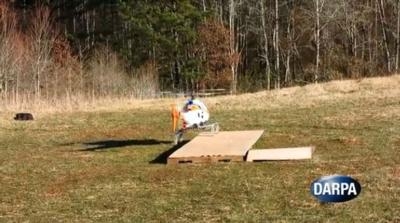Mon, Sep 21, 2015
Could Enable Future Aircraft To Take Off And Land Almost Anywhere
Helicopters are incredibly maneuverable in the air, but during landing and takeoff their traditional skid- and wheel-based landing gear requires stable, flat surfaces—surfaces that are often unavailable in helicopter-needy environs such as forward operating areas, ships at sea and natural-disaster zones. Having the ability to land on and take off from angled, irregular and moving surfaces would greatly expand the effectiveness of helicopters across many military and national security missions.

As part of its effort to provide such a breakthrough capability, DARPA has conducted an experimental demonstration of a novel robotic landing gear system. The adaptive system replaces standard landing gear with four articulated, jointed legs that are able to fold up next to the helicopter’s fuselage while in flight and are equipped with force-sensitive contact sensors in their feet. During landing, each leg extends and uses its sensors to determine in real time the appropriate angle to assume to ensure that the helicopter stays level and minimize any risk of the rotor touching the landing area.
“The equipment—mounted on an otherwise unmodified, unmanned helicopter—successfully demonstrated the ability to land and take off from terrain that would be impossible to operate from with standard landing gear,” said Ashish Bagai, DARPA program manager. Bagai described the previously unreleased results of the flight demonstration at Wait, What? A Future Technology Forum, in St. Louis.
Along with comprehensive dynamic simulation and structural analyses, the demonstration flight—conducted near Atlanta—indicated numerous potential benefits, Bagai said, including:
- Reduced risk of damage during hard landings, by as much as a factor of five, compared to conventional landing gear
- Stable landing and take-off on sloping terrain of up to 20 degrees, more than twice current limits, and on craggy, boulder-strewn or otherwise irregular terrain
- Ship landings in violent sea states
- Significant increase in capabilities with only a modest increase in landing gear weight
The robotic landing gear system was developed with funding from DARPA’s Mission Adaptive Rotor (MAR) program, and is now undergoing continued development by the Georgia Institute of Technology.
(Image from DARPA YouTube video)
More News
From 2023 (YouTube Version): Legacy of a Titan Robert (Bob) Anderson Hoover was a fighter pilot, test pilot, flight instructor, and air show superstar. More so, Bob Hoover was an i>[...]
Get The Latest in Aviation News NOW on Instagram Are you on Instagram yet? It's been around for a few years, quietly picking up traction mostly thanks to everybody's new obsession >[...]
Aero Linx: B-52H Stratofortress The B-52H Stratofortress is a long-range, heavy bomber that can perform a variety of missions. The bomber is capable of flying at high subsonic spee>[...]
Altimeter Setting The barometric pressure reading used to adjust a pressure altimeter for variations in existing atmospheric pressure or to the standard altimeter setting (29.92).>[...]
"Knowing that we play an active part in bettering people's lives is extremely rewarding. My team and I are very thankful for the opportunity to be here and to help in any way we ca>[...]
 Classic Aero-TV: Remembering Bob Hoover
Classic Aero-TV: Remembering Bob Hoover ANN FAQ: Follow Us On Instagram!
ANN FAQ: Follow Us On Instagram! ANN's Daily Aero-Linx (05.15.24)
ANN's Daily Aero-Linx (05.15.24) ANN's Daily Aero-Term (05.15.24):Altimeter Setting
ANN's Daily Aero-Term (05.15.24):Altimeter Setting Aero-News: Quote of the Day (05.16.24)
Aero-News: Quote of the Day (05.16.24)



